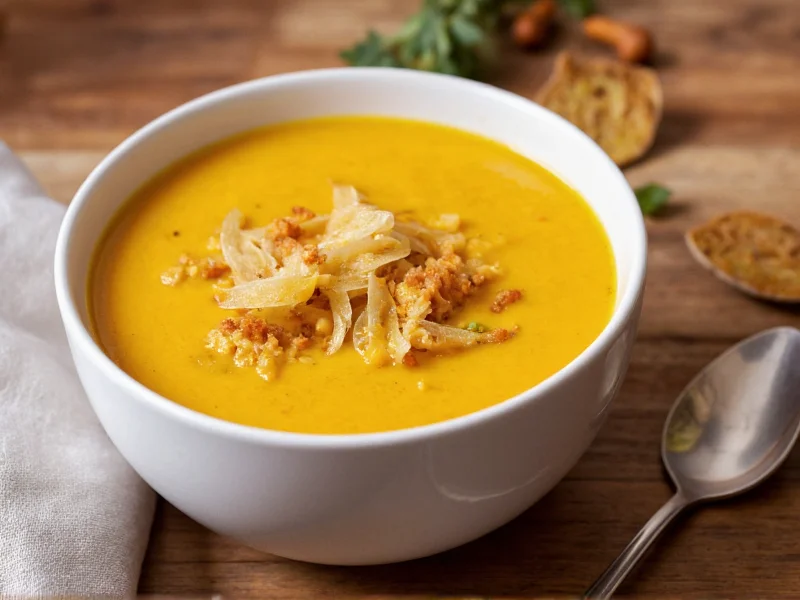Creating the perfect butternut squash soup requires understanding both technique and ingredient quality. This versatile fall and winter staple has become popular for good reason—it's nutritious, relatively simple to prepare, and adapts beautifully to various dietary preferences. Whether you're looking for an easy butternut squash soup recipe for beginners or wanting to elevate your technique, mastering this dish opens doors to countless comforting meals.
Essential Ingredients for Quality Butternut Squash Soup
The foundation of exceptional butternut squash soup starts with selecting quality ingredients. While recipes vary, certain components remain essential for achieving that perfect balance of sweet and savory:
- Fresh butternut squash (2-3 pounds): Choose squash with firm, unblemished skin and heavy weight for size
- Aromatic vegetables: Yellow onion (1 medium), garlic (3-4 cloves)
- Liquid base: Vegetable or chicken broth (4 cups), preferably low-sodium
- Fat component: Olive oil or butter (2-3 tablespoons) for sautéing
- Flavor enhancers: Fresh thyme (1 tablespoon), ground nutmeg (1/4 teaspoon)
- Seasoning: Salt and freshly ground black pepper to taste
Step-by-Step Preparation Method
Follow this reliable technique for creamy butternut squash soup without cream that achieves luxurious texture naturally:
- Prep the squash: Peel, seed, and cube squash into uniform 1-inch pieces
- Sauté aromatics: Heat oil in large pot, cook onions until translucent, add garlic
- Add squash and liquids: Combine squash, broth, thyme, and nutmeg in pot
- Simmer until tender: Cook 25-30 minutes until squash pierces easily with fork
- Blend until smooth: Use immersion blender or regular blender in batches
- Adjust seasoning: Add salt, pepper, and additional spices to taste
- Finish with garnish: Drizzle with olive oil or coconut milk before serving
Pro Tips for Perfect Butternut Squash Soup Every Time
Avoid common pitfalls with these professional techniques for homemade butternut squash soup:
- Roast for depth: For richer flavor, roast squash cubes at 400°F for 25 minutes before adding to soup
- Control consistency: Add broth gradually when blending to achieve desired thickness
- Acid balance: A splash of apple cider vinegar or lemon juice brightens flavors
- Texture matters: Blend in batches if using regular blender to prevent hot soup explosions
- Season in layers: Add salt at multiple stages rather than all at once
Nutritional Profile of Butternut Squash Soup
| Nutrient | Per Serving (1 cup) | Daily Value % |
|---|---|---|
| Calories | 185 | 9% |
| Total Fat | 7g | 9% |
| Saturated Fat | 1g | 5% |
| Carbohydrates | 30g | 11% |
| Dietary Fiber | 6g | 21% |
| Sugars | 8g | * |
| Protein | 3g | 6% |
| Vitamin A | 340% DV | 340% |
| Vitamin C | 50% DV | 50% |
Variations to Suit Different Preferences
Customize your healthy butternut squash soup to match dietary needs or flavor preferences:
- Vegan version: Use olive oil instead of butter and coconut milk for creaminess
- Spicy twist: Add 1/4 teaspoon cayenne pepper or a diced jalapeño with aromatics
- Curried variation: Stir in 1-2 tablespoons curry powder during sauté stage
- Apple complement: Add 1 peeled, diced apple with the squash for natural sweetness
- Protein boost: Top with roasted chickpeas or pumpkin seeds before serving
Storage and Reheating Guidelines
Proper storage ensures your butternut squash soup storage tips maintain quality:
- Refrigeration: Store in airtight container for up to 5 days
- Freezing: Portion into freezer-safe containers with 1-inch headspace for up to 3 months
- Reheating: Warm gently on stove over medium-low heat, adding broth if too thick
- Revitalizing: Stir in fresh herbs or a splash of cream after reheating for best flavor
Serving Suggestions for Complete Meals
Elevate your butternut squash soup for beginners with these pairing recommendations:
- Crusty artisan bread or garlic bread for dipping
- Simple green salad with apple cider vinaigrette
- Grilled cheese sandwich with sharp cheddar
- Roasted Brussels sprouts or kale as side
- Crumbled bacon or toasted pumpkin seeds as topping
Frequently Asked Questions
Can I make butternut squash soup without an immersion blender?
Yes, you can make butternut squash soup without an immersion blender. Carefully transfer small batches of the hot soup to a regular countertop blender, leaving the center cap off and covering with a towel to allow steam to escape. Blend until smooth, then return to pot. Never fill the blender more than halfway with hot liquid to prevent dangerous spills.
How do I prevent my butternut squash soup from being too watery?
To prevent watery butternut squash soup, reduce liquid during cooking by simmering uncovered for additional 10-15 minutes. Alternatively, after blending, return soup to heat and simmer gently until it reaches your desired consistency. Roasting the squash before adding to soup also concentrates flavors and reduces excess moisture.
What are the best spices to enhance butternut squash soup flavor?
The best spices for butternut squash soup include fresh thyme, ground nutmeg, cinnamon, and smoked paprika. For savory depth, add a bay leaf during simmering. A pinch of cayenne pepper provides subtle warmth without significant heat. Finish with fresh sage or rosemary just before serving for aromatic complexity.
Can I use frozen butternut squash for soup?
Yes, you can use frozen butternut squash for soup, though fresh typically yields better texture and flavor. If using frozen, thaw completely and drain excess liquid before cooking. You may need to adjust cooking time slightly as frozen squash has different moisture content. For best results, roast frozen squash before adding to soup to concentrate flavors.











 浙公网安备
33010002000092号
浙公网安备
33010002000092号 浙B2-20120091-4
浙B2-20120091-4